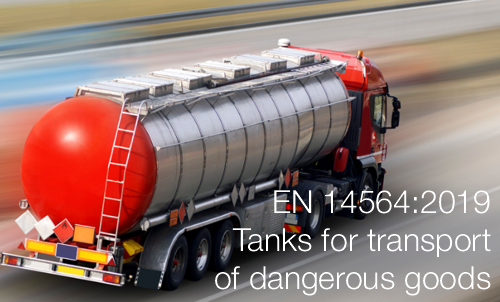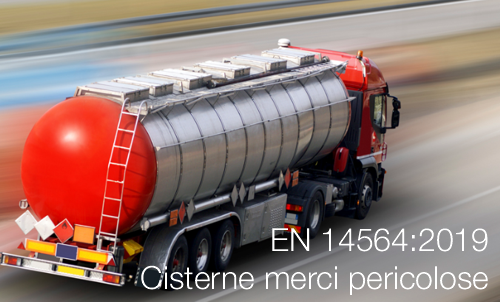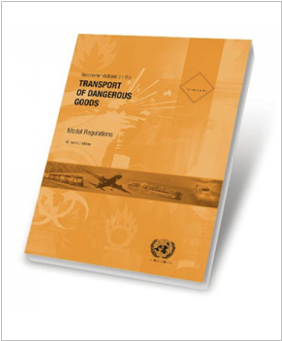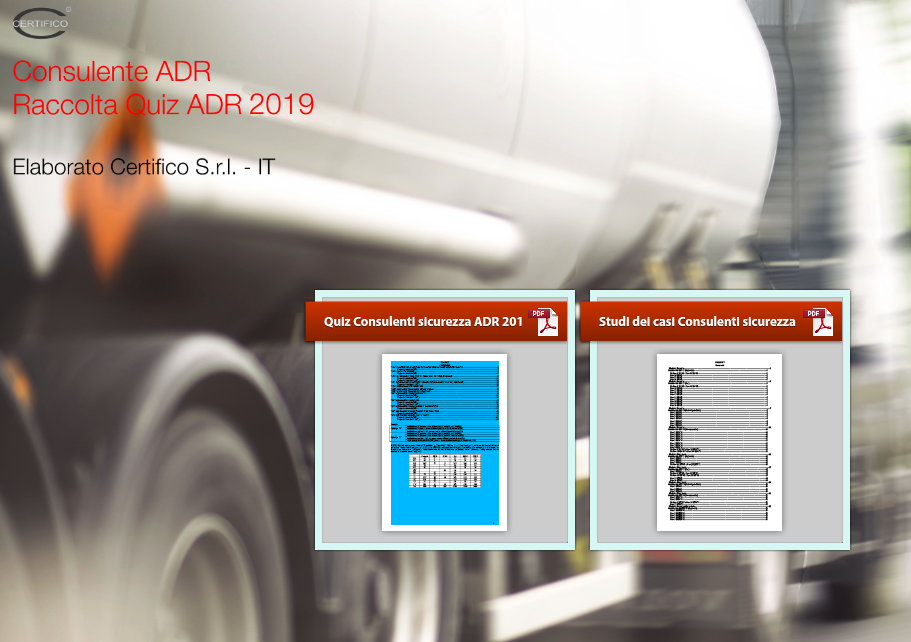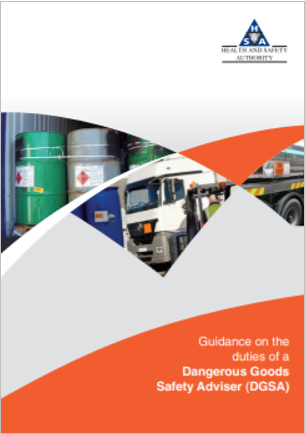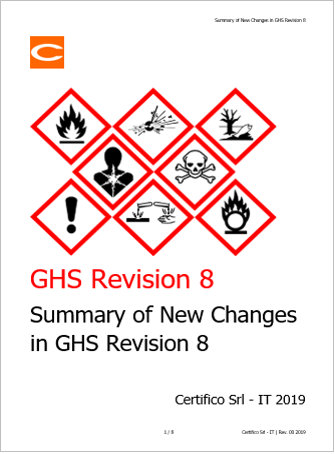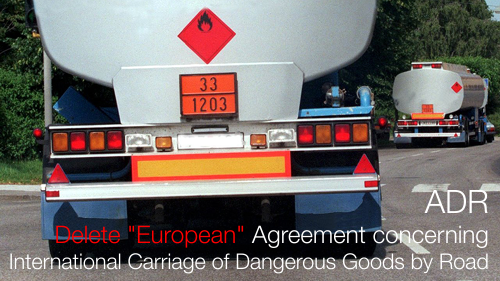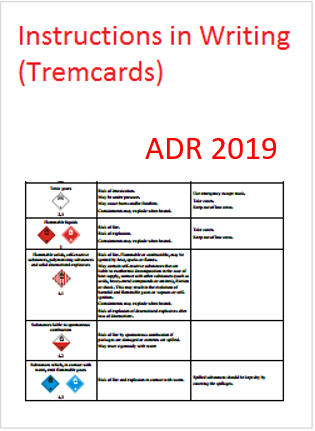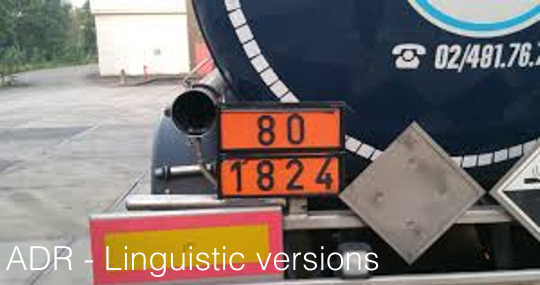Safety ADR / Dangerous Goods App
Safety ADR© è un’app per il trasporto di merci pericolose ADR che consente di:
– visualizzare tutta la Tabella A cap. 3.2 ADR per ONU/denominazione/classe/altro* (Italiano, Inglese);
– compilare per ciascuna materia ADR il “Report materia” con il parametro “Safety” (1) (Italiano, Inglese);
– compilare per ciascuna materia ADR la “Tremcards P.0” (2) (Italiano, Inglese);
– consultare le Istruzioni Scritte secondo l’ADR (Inglese, Italiano, Francese, Russo, Danese, Lettone, Norvegese, Svedese, Tedesco, Ungherese, Romeno, Portoghese, Ceco, Spagnolo, Turco, Sloveno, Slovacco, Estone, Neerlandese (Belgio), Neerlandese (Paesi Bassi), Polacco, Finlandese, Lituano, Bulgaro, Greco, Serbo);
– avere news in tempo reale visualizzate direttamente in Home;
– consultare l’accordo ADR (Inglese, Francese);
– consultare le etichette ADR, le classi, i Kemler (Italiano, Inglese).
EN 14564:2019 Tanks for transport of dangerous goods – Terminology
EN 14564:2019 Tanks for transport of dangerous goods – Terminology
This document provides additional terms and definitions to those written in the European Agreement Concerning the International Carriage of Dangerous Goods by Road (ADR) or the Regulations concerning the International Carriage of Dangerous Goods by Rail (RID), appearing as Appendix C to the Convention concerning International Carriage by Rail (COTIF).
This document forms part of series of documents prepared by CEN/TC 296 regarding the transport of dangerous goods. The series supports the proper application of the ADR and RID. This document is applicable to tanks used for the transport of dangerous goods.
This document does not apply to carriage in bulk of dangerous goods. For convenience, Annex A (informative) repeats some horizontal definitions taken from ADR 2017 chapter 1.2, and Annex B (informative) repeats some definitions from ADR 2017 chapter 6.7, specific to portable tanks. NOTE The ADR is updated on a regular basis, therefore Annexes A and B might become out of date. Annexes C, D and E (informative) provide alphabetical trilingual indexes of terms in English, French and German where the key is English, French and German respectively. Annex F (normative) is a schematic diagram of tank openings and closures according to the tank code
UNI EN 14564:2019 Cisterne trasporto di merci pericolose – Terminologia
UNI EN 14564:2019 Cisterne trasporto di merci pericolose – Terminologia
UNI EN 14564:2019 – La norma si applica alle cisterne utilizzate per il trasporto di merci pericolose e fornisce termini e definizioni aggiuntivi a quelli scritti nell’accordo europeo relativo al Trasporto Internazionale di Merci Pericolose su Strada (ADR) o alle regolamentazioni relative al Trasporto Internazionale di Merci Pericolose per Ferrovia (RID).
Data entrata in vigore: 14 novembre 2019
Recepisce: EN 14564:2019
Sostituisce: UNI EN 14564:2013
GHS Rev. 8 July 2019
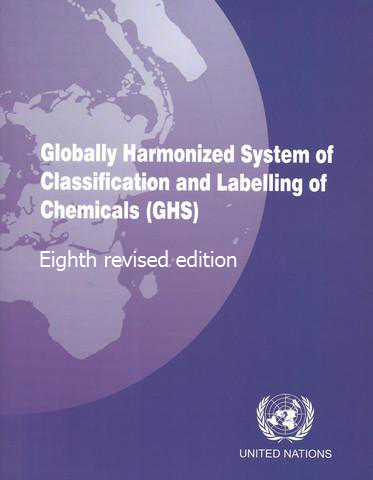
GHS Rev. 8 Luglio 2019 (Globally Harmonized System of Classification and Labelling of Chemicals)
Sistema mondiale armonizzato di classificazione ed etichettatura delle sostanze chimiche (GHS): Ottava edizione riveduta
Il GHS affronta la classificazione delle sostanze chimiche per i tipi di pericolo e vuole armonizzare tali tipi di pericoli, comprese etichette e schede di sicurezza.
Esso mira a garantire che le informazioni sui rischi fisici e la tossicità da sostanze chimiche siano le migliori possibili per l a tutela della salute umana e l’ambiente durante la manipolazione, trasporto e uso.
Il GHS fornisce anche una base per l’armonizzazione di norme e regolamenti sulle sostanze chimiche a livello nazionale, regionale e mondiale.
Questa ottava edizione rivista del GHS contiene varie disposizioni nuove o rivedute, tra cui, tra l’altro:
[alert]- nuovi criteri di classificazione, elementi di comunicazione dei pericoli, logiche decisionali e indicazioni per le sostanze chimiche sotto pressione;
– nuove disposizioni per l’uso di dati in vitro/ex vivo e metodi non sperimentali per valutare la corrosione e l’irritazione cutanea;
– emendamenti vari per chiarire i criteri di classificazione per la tossicità specifica per organi bersaglio;
– dichiarazioni precauzionali riviste e ulteriormente razionalizzate e una revisione editoriale delle sezioni 2 e 3 dell’allegato 3;
– nuovi esempi di pittogrammi precauzionali per trasmettere la frase precauzionale “Tenere fuori dalla portata dei bambini”;
– un nuovo esempio nell’allegato 7 relativo all’etichettatura di set o kit; e
– guida per l’identificazione dei pericoli di esplosione della polvere e la necessità di valutazione dei rischi, prevenzione, mitigazione e comunicazione dei pericoli.[/alert]
Fonte: UNECE 2019
UN Model Regulations 21A Revised edition (2019)
UN Model Regulations 21A Revised edition (2019)
At its ninth session (7 December 2018), the Committee adopted a set of amendments to the Model Regulations on the Transport of Dangerous Goods, concerning, inter alia, electric storage systems (including lithium batteries installed in cargo transport units and defective batteries), explosives, infectious waste of Category A, waste gas cartridges, harmonization with the 2018 Edition of IAEA’s Regulations for the Safe Transport of Radioactive Material, listing of dangerous goods, update of LC50 values for some toxic gases and use of in vitro skin corrosion methods for classification.
This twenty-first revised edition of the Recommendations takes account of all the amendments which were circulated as document ST/SG/AC.10/46/Add.1.
Volume I (EN/FR)
Volume I (EN/FR)
Official UN publications can also be obtained through the UN Bookshop and official distributors.
…
Fonte: UNECE
Consulente DG: Raccolta Quiz esame ADR 2019
Consulente DG: Raccolta Quiz esame ADR 2019
Aggiornamento ADR 2019
La Direzione Generale per la Motorizzazione ha predisposto dei quiz aggiornati con l’ARD/RID 2019, per i candidati che si accingono a sostenere l’esame per il conseguimento o il rinnovo del certificato di formazione professionale di consulente per la sicurezza del trasporto di merci pericolose.
Tali quiz rappresentano materiale in sede di esame per il conseguimento/rinnovo del suddetto certificato, fermo restando che le Commissioni di esame nella loro autonomia possono predisporre dei propri quiz.
Edizione 2019
1. Quiz ADR/RID 2019
2. Studi dei casi 2019
Elaborato Adobe portfolio
Certifico S.r.l. – IT Settembre 2019
Guidance duties Dangerous Goods Safety Adviser (DGSA)
Guidance on the duties of a Dangerous Goods Safety Adviser (DGSA)
This guidance is intended to inform Dangerous Goods Safety Advisers (DGSAs) and those undertakings which need to appoint a DGSA, about the roles and responsibilities of a DGSA. A DGSA has specific duties under the European Agreement Concerning the International Carriage of Dangerous Goods by Road (ADR), which will be detailed in this document. An undertaking may need to appoint a DGSA if it is involved in the following activities:
– Consigning dangerous goods for transport including, including as appropriate, loading, packing and filling (consignors).
– Operation of road vehicles carrying dangerous goods, including as appropriate, packing, loading, filling and unloading (carriers).
The ADR specifies the responsibilities of a Safety Adviser in Chapter 1.8.3 The core responsibilities of a Safety Adviser are as follows:
– Advising undertakings on the safe transport of dangerous goods by road.
– Monitoring the undertakings compliance with dangerous goods regulations.
– Preparing an annual report about the activities of the undertaking related to the transport dangerous goods.
– Investigating any accidents or infringements of regulations and preparing reports.
– Monitoring the provision of training and advice to any staff involved in the transport of dangerous goods.
The duties of those who accept the appointment of DGSA for an undertaking are mandatory. A DGSA or employer does not have the discretion to “cherry pick” the duties or roles which they must observe and fulfil. The role of a DGSA is such that fulfilling the responsibilities as detailed in the ADR attracts a legal duty of care for the DGSA. A regulatory body or competent authority in any of the EU or non-EU member states who are signatories to the ADR may require the identity of the DGSA acting for an undertaking. It is your duty as an undertaking involved in the carriage, loading or unloading of dangerous goods, or as an appointed DGSA, to comply in a timely fashion with any lawful request of any such regulatory body.
…
HSA 2015
Multilateral agreements: State 11 August 2019
Multilateral agreements: State 11 August 2019
List of Bilateral and Multilateral Agreements
Procedures to be followed for the communication of multilateral agreements concluded in accordance with Section 1.5.1 of ADR
GHS Rev.8 (2019) Preview
GHS Rev.8 (2019)
On 18 March 2019, the Committee of Experts on TDG and GHS of the UNECE has published approved amendments to the seventh revised edition of UN GHS purple book. These changes are going to be included in the 8th edition of UN GHS purple book (GHS rev. 8) to be published in July 2019. In this article we will summarize what the main new changes are.
Change of classification criteria for aerosols, hazard communication elements; new provisions for the use of in vitro/ex vivo data and non-test methods to assess skin corrosion and skin irritation; miscellaneous amendments to clarify the classification criteria for Specific Target Organ Toxicity; revised and further rationalized precautionary statements and an editorial revision of Sections 2 and 3 of Annex 3; new examples of precautionary pictograms to convey the precautionary statement “Keep out reach of children”; a new example in Annex 7 addressing labelling of sets or kits; guidance on the identification of dust explosion hazards and the need for risk assessment, prevention, mitigation, and hazard communication.
Remove the word “European” from the title of the ADR
Remove the word “European” from the title of the ADR
A protocol of amendment to remove the word “European” from the title of the ADR was adopted by a Conference of the Parties to the Agreement on Monday 13 May 2019.
The amendment shall enter into force for all Parties to the Agreement on 1 January 2021.
Eliminata la parola “Europeo” dal titolo dell’ADR
Eliminata la parola “Europeo” dal titolo dell’ADR (Proposta senza obiezioni)
Working Party on the Transport of Dangerous Goods
104th session Geneva, 15-17 May 2018
Punto 8 dell’ordine del giorno provvisorio – altra attività
Procedura di revisione del titolo di ADR
1. Nella sua 103a sessione (6-10 Novembre 2017), il gruppo di lavoro ha esaminato la proposta di sopprimere il termine “europeo” dal titolo di ADR.
2. È stato osservato che il termine “europeo” nell’attuale titolo dell’Accordo europeo relativo al trasporto internazionale di merci pericolose su strada (ADR) non è conforme alle condizioni per la partecipazione di Stati non europei all’ADR, come, conformemente al suo articolo 6, l’ADR è aperto alla partecipazione degli Stati membri della Commissione economica per l’Europa e degli Stati ammessi alla Commissione a titolo consultivo a norma del paragrafo 8 del mandato della Commissione.
L’ADR è inoltre aperto a quegli Stati che possono partecipare ad alcune attività della Commissione economica per l’Europa conformemente al paragrafo 11 del mandato della Commissione aderendovi dopo la sua entrata in vigore.
3. Non c’erano obiezioni alla proposta.
Il gruppo ha chiesto al segretariato di consultare nuovamente l’ufficio degli affari giuridici del segretariato delle Nazioni Unite sulla procedura da seguire e di presentare una versione aggiornata del documento ECE/TRANS/2010/2 alla 104a sessione.
Instructions in Writing – State ADR 2019
Instructions in Writing (Tremcards) ADR 2019
The official models of Instructions in Writing (Tremcards) ADR 2019
Annex Article tremcards the release date, we will update the models attached to the official release on the UNECE website.
Update 11.06.2019
https://www.certifico.com/merci-pericolose/adr/tremcards-adr
ADR – Linguistic versions
ADR – Linguistic versions
European Agreement concerning the International Carriage http://www.unece.org/trans/danger/publi/adr/adr_linguistic_e.htmof Dangerous Goods by Road
|
To consult ADR in Polish:http://dziennikustaw.gov.pl/du/2019/769 |
||
| To consult ADR in Spanish: ADR en Español | ||
|
To consult ADR and the list of amendments in Swedish: http://www.msb.se/sv/Forebyggande/Farligt-gods/ |
||
| To consult ADR 2019 in Norwegian: https://www.dsb.no/globalassets/dokumenter/veiledere-handboker-og-informasjonsmateriell/andre-boker/adr-rid-2019-web.pdf | ||
|
To consult ADR in Romanian: ADR in Romanian |




